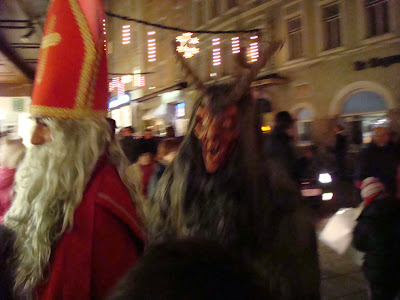Can you help us solve a family mystery?
When I was growing up, my mother would occasionally make a very special dish for us:
Stats
She had learned to make
stats from her mother, who learned it from her mother and so on. The only thing we know for certain is that it is an Austrian peasant dish. Essentially stats is an extra egg-y pancake batter than is then fried in a bit of oil. Sometimes it would have chunks of apple in it. We would serve it for lunch or dinner, sprinkled with powder sugar and always with a side of dill pickles. (To cut the sweet, of course!)
Here is a photo of
stats (with raisins and roasted almonds added):

It is a very important dish in my family. Mostly because there is little remaining from my maternal grandmother. (
Pictured below with my grandfather from an undated photo taken while on vacation in New York City.)

Grandma Rausch was the daughter of immigrants from Vienna, Austria. Although she was born in the United States, most of her cooking was Austrian in nature. She learned the recipes from her mother and she kept all of them in her head. Few were ever written down.
She always meant to write down these family recipes, but she just never got around to it. Unfortunately, she died unexpectedly when she was 54 years old. When she died, many of the family recipes were lost with her.
Some of the recipes, such as
stats or
Sauerbraten or
Apfel Strudel were learned by my mother and her sisters, cooking side by side with my grandmother while they were young and living at home. But none of them learned more than a few.
Since my grandmother's death in the 1960's, they have tried to recreate many of the recipes that are now gone. They have poured through German & Austrian cookbooks, trying out recipes and making small changes to recreate the taste and smell of their childhood. In some cases, they were successful. But in many cases, no information could be found.
Part of the issue is that although my grandmother was fluent in German, she never taught the language to any of her children. Primarily because German was the language the adults used when they didn't want the children to understand what they were saying. But perhaps also because during that time period (between the 2 World Wars), you didn't really want to advertise that you spoke German.
So in many cases, we do not even know what the dishes are really called. Because my mother and her siblings did not speak German, the German names of the recipes have been warped or lost completely. For example, there is one dish that the family calls "baby fingers" because they are small noodles served with gravy that are about the size of a baby's fingers. But not
spaetzle!
Stats is one of those dishes. Over the years we have repeatedly tried to find the history and origins of this dish. We have done countless searches in cookbooks, asked virtually every Austrian we came into contact with and researched it on the internet.
The first break-through came a few years ago on a visit to Münich. I described the dish in detail to Laurie, an American who lived in Münich for nearly 20 years. She thought it sounded like
Kaiserschmarrn. It is very close. Indeed, the closest we have ever come.
While my parents were visiting earlier this month, we took the opportunity to taste
Kaiserschmarrn in Münich, Nuremburg and Salzburg. My mother was thrilled to have gotten so close. But we both agreed it is not quite right. And we couldn't figure out where the name "
stats" had come from. Obviously it is the wrong name, but could it really have warped so much from
Kaiserschmarrn to
stats? In just a generation?
After we returned from the Christmas Market (and Kaiserschmarrn) Marathon, GLH happened to mention it to an Austrian co-worker.
"Ah," the co-worker said, "
Stats actually sounds more like S
terz. Also called
Mehlsterz." So I immediately did some research.
Sterz is fried flour with no eggs, milk or sugar. So not the correct recipe, but perhaps where the name originates?
Further research revealed a recipe called
Mehlschmarrn, which is almost identical to the recipe my mother remembers. It is an Austrian peasant dish that is intended to be eaten as a meal, not dessert as
Kaiserschmarrn is. Generally, it was eaten when times were hard and there was little money for meat and other, more expensive, ingredients.
Being a librarian, I took the research further still.
Apparently
Sterz refers to a recipe specific to the Styrian region of Austria. It has been around for quite literally centuries. There are variations of it all over the country. Perhaps the Viennese version included the eggs, milk and sugar?
Also, I may have found a connection to
Kaiserschmarrn. The chef who originally made the recipe based it upon an Austrian peasant dish that he learned from his mother and grandmother. Definitely getting closer...
So now I would like your input -- especially the input of Austrians who may remember variations of this dish from their childhood.
Anyone out there in the Blogosphere?


















